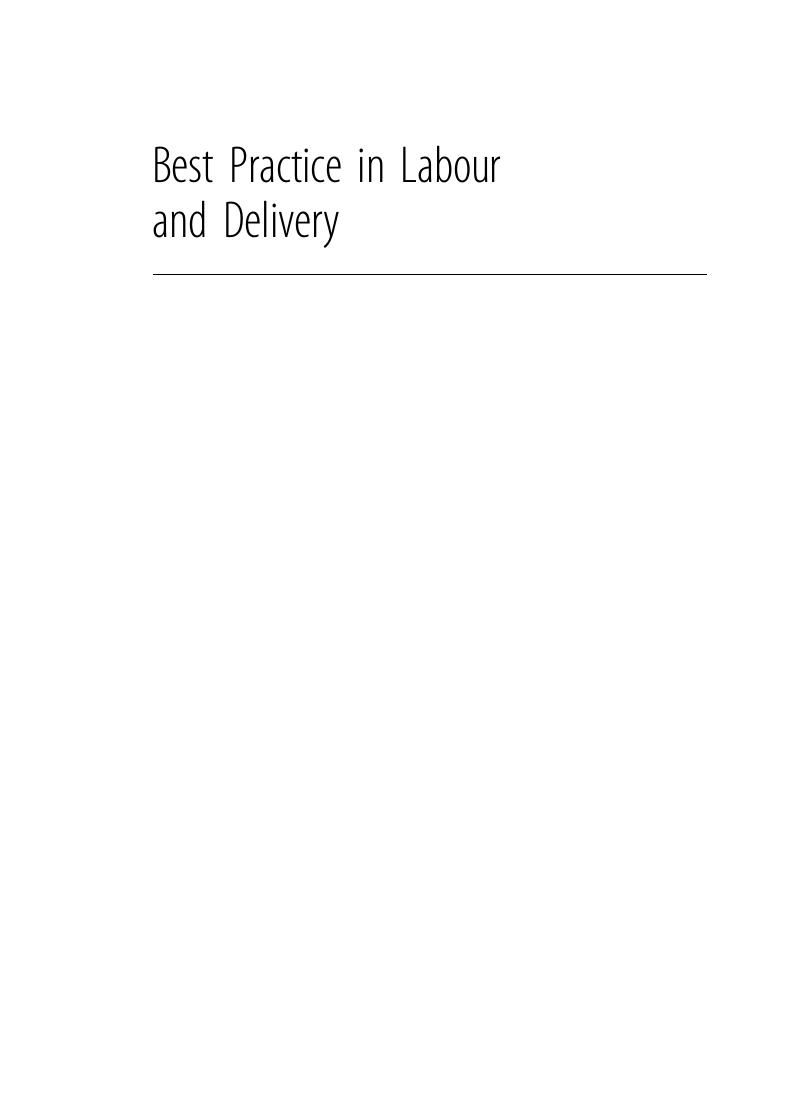Book contents
- Best Practice in Labour and Delivery
- Best Practice in Labour and Delivery
- Copyright page
- Contents
- Contributors
- Preface
- Acknowledgements
- Chapter 1 Pelvic and fetal cranial anatomy and mechanism of labour
- Chapter 2 The first stage of labour
- Chapter 3 Analgesia and anaesthesia in labour
- Chapter 4 Intrapartum fetal surveillance
- 5 Uterine contractions
- Chapter 6 The management of intrapartum ‘fetal distress’
- Chapter 7 Nutrition and hydration in labour
- Chapter 8 Prolonged second stage of labour including difficult decision-making on operative vaginal delivery and caesarean section
- Chapter 9 Operative vaginal deliveries: indications, techniques and complications
- Chapter 10 Caesarean deliveries: indications, techniques and complications
- Chapter 11 Breech and twin delivery
- Chapter 12 Cord prolapse and shoulder dystocia
- Chapter 13 Antepartum haemorrhage
- Chapter 14 Management of the third stage of labour
- Chapter 15 Postpartum haemorrhage (PPH)
- 16 Acute illness and maternal collapse in the postpartum period
- 17 Episiotomy and obstetric perineal trauma
- 18 Induction of labour
- 19 Preterm prelabour rupture of membranes (pPROM)
- 20 Preterm labour and delivery
- 21 Labour in women with medical disorders
- 22 Management of women with previous caesarean section
- Chapter 23 Rupture of the uterus
- 24 Management of severe pre-eclampsia/eclampsia
- Chapter 25 Neonatal resuscitation and the management of immediate neonatal problems
- Chapter 26 The immediate puerperium
- 27 Triage and prioritization in a busy labour ward
- 28 Risk management related to intrapartum care
- 29 Teamworking, skills and drills
- Chapter 30 Cerebral palsy arising from events in labour
- 31 Objective Structured Assessment of Technical Skills (OSATS) in obstetrics
- Appendix
- Index
Best Practice in Labour and Delivery
Published online by Cambridge University Press: 15 March 2010
- Best Practice in Labour and Delivery
- Best Practice in Labour and Delivery
- Copyright page
- Contents
- Contributors
- Preface
- Acknowledgements
- Chapter 1 Pelvic and fetal cranial anatomy and mechanism of labour
- Chapter 2 The first stage of labour
- Chapter 3 Analgesia and anaesthesia in labour
- Chapter 4 Intrapartum fetal surveillance
- 5 Uterine contractions
- Chapter 6 The management of intrapartum ‘fetal distress’
- Chapter 7 Nutrition and hydration in labour
- Chapter 8 Prolonged second stage of labour including difficult decision-making on operative vaginal delivery and caesarean section
- Chapter 9 Operative vaginal deliveries: indications, techniques and complications
- Chapter 10 Caesarean deliveries: indications, techniques and complications
- Chapter 11 Breech and twin delivery
- Chapter 12 Cord prolapse and shoulder dystocia
- Chapter 13 Antepartum haemorrhage
- Chapter 14 Management of the third stage of labour
- Chapter 15 Postpartum haemorrhage (PPH)
- 16 Acute illness and maternal collapse in the postpartum period
- 17 Episiotomy and obstetric perineal trauma
- 18 Induction of labour
- 19 Preterm prelabour rupture of membranes (pPROM)
- 20 Preterm labour and delivery
- 21 Labour in women with medical disorders
- 22 Management of women with previous caesarean section
- Chapter 23 Rupture of the uterus
- 24 Management of severe pre-eclampsia/eclampsia
- Chapter 25 Neonatal resuscitation and the management of immediate neonatal problems
- Chapter 26 The immediate puerperium
- 27 Triage and prioritization in a busy labour ward
- 28 Risk management related to intrapartum care
- 29 Teamworking, skills and drills
- Chapter 30 Cerebral palsy arising from events in labour
- 31 Objective Structured Assessment of Technical Skills (OSATS) in obstetrics
- Appendix
- Index
Summary

- Type
- Chapter
- Information
- Best Practice in Labour and Delivery , pp. i - iiPublisher: Cambridge University PressPrint publication year: 2009

